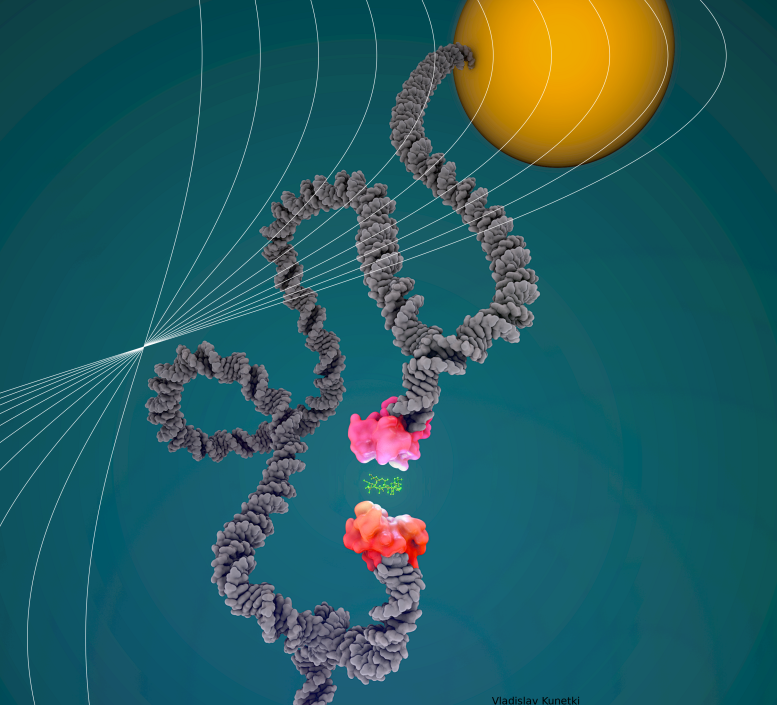
Illustration showing a DNA scaffold holding two proteins close together while their bond is characterized using acoustic force spectroscopy. Credit: Vladimir Kunetki
We rely on temporary protein-protein bonds for essential processes including enzymatic reactions, antibody binding, and response to medication. The ability to precisely characterize these interactions is crucial for evaluating the efficacy of potential treatments. However, the existing methodologies for this purpose are restricted in their capabilities, either in terms of producing detailed insights at the level of individual interactions or in examining vast quantities of these interactions.
In a study recently published in the Biophysical Journal, scientists unveiled an improved technique for evaluating the durability and robustness of protein-protein bonds under conditions that mimic those within our bodies. The method uses sound waves to pull bonded proteins apart and DNA leashes to keep the two proteins close together so that they can re-bond after their connection is ruptured. This innovation allows the same protein bonds to be re-tested up to 100 times, providing valuable information about how bond strength changes as molecules age.
“We wanted to propose a method that is sufficiently modular to apply to different types of bonds, that has a reasonable throughput, and that reaches high molecular precision that is currently only available with very refined techniques, like optical or magnetic tweezers, that are often difficult to grasp for non-specialists,” says senior author Laurent Limozin, a biophysicist at the Centre National de la Recherche Scientifique (CNRS).
To do this, Limozin’s team, in collaboration with colleagues from Marseille and Paris, combined two existing technologies: acoustic force spectroscopy, which allows many molecular pairs to be tested simultaneously, and DNA scaffolds, which enable the same bonds to be tested repeatedly.
During acoustic force spectroscopy, pairs of bonded proteins are tested inside a liquid-filled chamber. The proteins are restrained by DNA scaffolding such that one strand of DNA attaches the first protein to the bottom of the chamber, while another strand attaches the second protein to a small silica bead. When the researchers blast the chamber with a soundwave, the wave’s force pulls the silicon bead—and the protein it’s attached to—away from the bottom of the chamber. If the force is strong enough, this pulling action ruptures the bond between the two proteins. However, in this new method, a third strand of DNA acts as a leash to keep the proteins close together after their bond is ruptured.
“The originality of our method is that in addition to these two strands on each side, in the middle you have this leash that connects the two strands and keeps the proteins together upon rupture,” says Limozin. “Without this leash, the detachment would be irreversible, but this allows you to repeat the measurement almost as many times as you wish.
As a proof of concept, the research team used the technique to characterize two single-molecule interactions of biomedical interest— the bond between proteins and rapamycin, an immunosuppressive drug, and the bond between a single-domain antibody and an HIV-1 antigen.
The researchers observed these cycles of bonding and rupturing using a microscope. Being able to test the same protein-protein bond multiple times is important for exploring variation between molecularly identical pairs. It also allows researchers to examine how these interactions change as the molecules age, which could be important for determining the half-life of drugs or antibodies.
“With this tool, we have a way to go deeper and really probe experimentally ideas about molecular heterogeneity and molecular aging,” says Limozin. “We, and others, suspect that characterizing these properties will be very useful for designing future therapeutics that will need to work in situations where mechanical forces are involved.”
Reference: “Combining DNA scaffolds and acoustic force spectroscopy to characterize individual protein bonds” by Yong Jian Wang, Claire Valotteau, Adrien Aimard, Lorenzo Villanueva, Dorota Kostrz, Maryne Follenfant, Terence Strick, Patrick Chames, Felix Rico, Charlie Gosse and Laurent Limozin, 7 June 2023, Biophysical Journal.
DOI: 10.1016/j.bpj.2023.05.004
The study was funded by AMIDEX Emergence Innovation, the Plan Cancer PhysCancer program, the European Research Council, the Human Frontier Science Program, and PSL University.


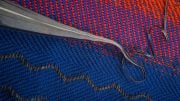

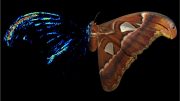
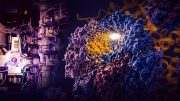
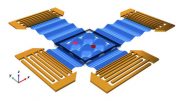
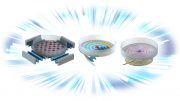

Be the first to comment on "Harnessing the Power of Sound: A Novel Method To Test Protein Bonds"